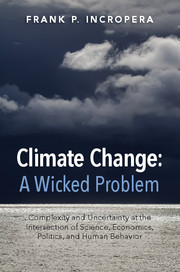 Climate Change: A Wicked Problem
Climate Change: A Wicked Problem Published online by Cambridge University Press: 05 October 2015
Public policy measures can do much to accelerate deployment of carbon mitigation measures, and there are basically three options. One approach is to put a price on emissions, which can be done through a cap-and-trade system or an outright tax. The approach is motivated by the following premise: if the goal is to put a large dent in GHG emissions, a price tag must be put on the emissions. A second approach is to mandate reductions through the regulatory process. Forms of government regulation could include corporate average fuel economy (CAFE) standards for automotive transportation, renewable portfolio standards (RPS) for power production, and efficiency standards for buildings and home appliances. The third approach is to provide financial incentives to ease the cost of mitigation. Incentives can be provided as outright grants, tax credits for producing carbon-free energy, or preferential treatment for sale of the energy.
In each of the three approaches, a critical issue, both politically and economically, is cost management. If costs are too high, economic growth is stifled; if they are too low, emission reductions and innovation are stifled.
Cap-and-trade
Lawmakers are generally averse to increasing taxes. Hence, if they believe that a price should be placed on carbon emissions, they're inclined to favor a cap-and-trade system, even though, like a tax, the cost of implementation is ultimately borne by the consumer. In principle, the system works as follows. Governments impose caps (limits) on GHG emissions from large central sources such as power plants, oil refineries, natural gas producers, and manufacturers of energy-intensive products such as concrete, steel, and glass. Initially, the caps are high to allow time for adjustment but are gradually reduced until atmospheric GHG concentrations drop to desired levels. Commensurate with a prescribed cap, permits (allowances) are granted and/or auctioned to the emitting entities, with one permit corresponding to a unit of annual emissions such as 1 t-CO2eq.
Whether auctioned or granted, permits are traded on a market, which can be regional, national, or international. Permits are sold by those able to economically reduce emissions below their cap and bought by those finding such purchases to be a more cost-effective approach to compliance.
To save this book to your Kindle, first ensure no-reply@cambridge.org is added to your Approved Personal Document E-mail List under your Personal Document Settings on the Manage Your Content and Devices page of your Amazon account. Then enter the ‘name’ part of your Kindle email address below. Find out more about saving to your Kindle.
Note you can select to save to either the @free.kindle.com or @kindle.com variations. ‘@free.kindle.com’ emails are free but can only be saved to your device when it is connected to wi-fi. ‘@kindle.com’ emails can be delivered even when you are not connected to wi-fi, but note that service fees apply.
Find out more about the Kindle Personal Document Service.
To save content items to your account, please confirm that you agree to abide by our usage policies. If this is the first time you use this feature, you will be asked to authorise Cambridge Core to connect with your account. Find out more about saving content to Dropbox.
To save content items to your account, please confirm that you agree to abide by our usage policies. If this is the first time you use this feature, you will be asked to authorise Cambridge Core to connect with your account. Find out more about saving content to Google Drive.